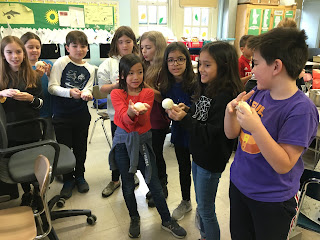What makes bread RISE?
Today we got the chance to mix flour, water, yeast & salt to make bread. The chemistry of bread making including the chemical reaction and cellular respiration and fermentation process.
A special "Thank You" to Iker's mom, Martha for her amazing demonstration lesson on bread making, the children will learn the chemistry of bread making in their science class.
Soft shelled breads should be baked at lower temperatures. When you increase the temperature of your oven your bread bakes quicker. Professional bakers of rustic breads use ovens that achieve higher temperatures than home ovens achieve.
Soft bread is soft because CO2 produced by yeast and water that gets turned to steam by the baking process gets trapped into pockets by a mesh of gluten, causing the dough to expand.
A special "Thank You" to Iker's mom, Martha for her amazing demonstration lesson on bread making, the children will learn the chemistry of bread making in their science class.
Gluten proteins are the most important protein group in bread making. Gluten
forms when water is added to flour and is mixed. During mixing, a
continuous network of protein forms, giving the dough its strength and
elasticity. By holding gas produced during fermentation, the protein
network allows bread to rise.
If you add more yeast to a bread dough, the dough will rise faster. ... The dough may rise too quickly and produce too much gluten. When this happens, the dough may collapse -- similar to a balloon bursting when it's filled with too much air.
Soft shelled breads should be baked at lower temperatures. When you increase the temperature of your oven your bread bakes quicker. Professional bakers of rustic breads use ovens that achieve higher temperatures than home ovens achieve.
The carbon dioxide produced in these reactions causes the dough to rise
(ferment or prove), and the alcohol produced mostly evaporates from the
dough during the baking process. During fermentation each yeast cell
forms a centre around which carbon dioxide bubbles form.
So go forth, and bake!















































































